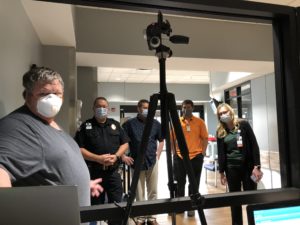
In a press release from Naval Surface Warfare Center, Crane Division (NSWC Crane), the NSWC Crane organization describes how they have partnered with Greene County General Hospital to provide a thermal imaging solution during coronavirus pandemic. GCGH has implemented the technology in their main lobby entrance and will begin using the technology to screen staff, patients and visitors for potential fevers.
From NSWC Crane:
CRANE, Ind. – Naval Surface Warfare Center, Crane Division (NSWC Crane) is providing its sensor agnostic thermal imaging system to Greene County General Hospital (GCGH) to screen incoming staff and patients for fever, a symptom of COVID-19. NSWC Crane has licensed the technology to GCGH and will loan and set up the necessary equipment for a trial run at GCGH as part of a new Cooperative Research and Development Agreement (CRADA).
In April, NSWC Crane released its patent portfolio to stimulate the economy and encourage innovative solutions. The Rapid Response Licensing Program made any of Crane’s 300+ patented technologies royalty free for 12 to 18 months, depending on whether the repurposed technologies directly aim to solve complications stemming from the COVID-19 pandemic.
“The purpose of Technology Transfer is so that the public can feel the benefit of their tax dollars,” said Jenna Dix, NSWC Crane’s Technology Transfer (T2) Director. “This project is one way the Greene County community can directly share in the investments made into NSWC Crane.”
To use the software, any laptop with capture card, most commercial infrared sensors, and a calibrated black body are necessary. The black body is a scientific tool used as the temperature reference. The software uses the black body temperature to compare with the temperature of a person. The system is capable of detecting fevers in near real time – every 0.016 seconds. It works on individuals and moving crowds from a few feet to a distance of approximately 200 yards.
Stacy Burris, MPA-Director of Foundation and Community Outreach at GCGH, said the Crane technology could lighten the load on their staff members and allow for an improved staff to patient ratio.
“Since the tech can detect temperatures in a crowd and from a long distance, it’s more flexible than other solutions we had been looking at,” said Burris. “This will cause less interruption in normal operations and allow for more social distancing between staff and anyone coming into the hospital. That could mean less screening staff having to quarantine from exposure.”
Burris said her team had been discussing solutions and researching commercial equipment for fever detection but had not found any satisfactory solutions until they learned of Crane’s thermal imaging technology. Within a day, Radius Indiana had connected the GCGH team with NSWC Crane, and the T2 office started the CRADA process.
“Without Crane, we might still be weighing the pros and cons of other solutions,” said Burris. “Instead, we’re already working to schedule a time for the Crane scientists to set the equipment up. The Rapid Response program has allowed us to get an affordable solution quickly, a huge benefit for a small hospital like GCGH. With this, we don’t have to spend time applying for grants and waiting for them to come through – we can start alleviating our staff almost immediately.”
Dix said this CRADA is a perfect example of the benefits of T2.
“This technology was made for sailors and Department of Defense civilians, but has applicability just about anywhere,” said Dix. “We want Crane’s resources to be made available to others – out of the lab and right into the hands of the public.”
Burris said many hospitals are struggling with similar problems, and she hopes GCGH’s trial run with the technology will pave the way for other hospitals’ involvement.
“Our board and CEO are excited about this innovative and out-of-the-box partnership,” said Burris. “Crane invented this tech, and now it’s being used right here in Greene County. We’re thrilled to be in this partnership and helping create strong community ties.” for more information click here.
About NSWC Crane
NSWC Crane is a naval laboratory and a field activity of Naval Sea Systems Command (NAVSEA) with mission areas in Expeditionary Warfare, Strategic Missions and Electronic Warfare. The warfare center is responsible for multi-domain, multi- spectral, full life cycle support of technologies and systems enhancing capability to today’s Warfighter.
Join Our Team! NAVSEA employs a diverse, highly trained, educated, and skilled workforce – from students and entry level employees to experienced professionals and individuals with disabilities. We support today’s sophisticated Navy and Marine Corps ships, aircraft, weapon systems and computer systems. We are continuously looking for engineers, scientists, IT and cyber specialists, as well as trade and other support professionals to ensure the U.S. Navy can protect and defend America. Please contact NSWC Crane Human Resources at crane_recruiting@navy.mil.



